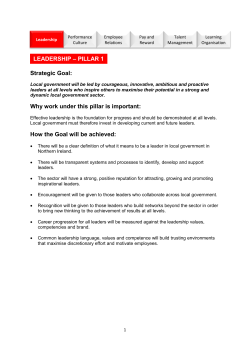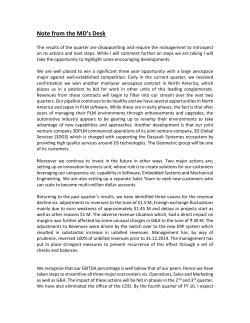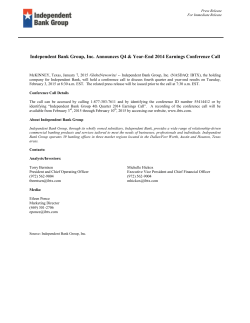
Management Discussion at 3/31/15
Partners Fund Longleaf Partners Funds ▪ 7 Partners Fund Management Discussion Longleaf Partners Fund declined 1.09% in the first quarter, trailing the S&P 500 Index’s 0.95% gain. While the Partners Fund has lagged the Index in the recent periods shown below, the Fund’s longer term outperformance over 15, 20, and 25 years reflects other stretches of falling behind the index followed by bursts of strong relative returns. Cumulative Returns at March 31, 2015 Since Inception 25 Year 20 Year 15 Year Partners Fund (Inception 4/8/87) 1821.17% 1302.92% 536.17% 224.51% S&P 500 Index 1235.74 934.05 502.33 Ten Year 76.13% Five Year 71.19% One Year 1Q 3.50% -1.09% 84.03 116.10 96.51 12.73 15 Year Ten Year Five Year One Year 3.50% 0.95 Average Annual Returns at March 31, 2015 Since Inception Partners Fund (Inception 4/8/87) S&P 500 Index 25 Year 11.14% 11.14% 9.70 9.79 20 Year 9.69% 8.16% 5.82% 11.35% 9.39 4.15 8.01 14.47 12.73 Returns reflect reinvested capital gains and dividends but not the deduction of taxes an investor would pay on distributions or share redemptions. Performance data quoted represents past performance; past performance does not guarantee future results. The investment return and principal value of an investment will fluctuate so that an investor’s shares, when redeemed, may be worth more or less than their original cost. Current performance of the fund may be lower or higher than the performance quoted. Performance data current to the most recent month end may be obtained by visiting longleafpartners.com. The total expense ratio for the Partners Fund is 0.91%. The expense ratio is subject to fee waiver to the extent normal annual operating expenses exceed 1.50% of average annual net assets. During the quarter the majority of our businesses had solid operating performance, coupled with value-accretive actions taken by our management partners. Many names were positive performers. Despite positive progress across the portfolio, the persistence of two broad headwinds – falling energy prices and U.S. dollar strength – weighed on returns. Our energy-related holdings were the largest return detractors and erased what otherwise was benchmark outperformance. We had positive local returns in our three European holdings, but the currency translation into U.S. dollars negatively impacted absolute and relative performance by 1.6%. The Partners Fund’s largest positive contributor, CK Hutchison (formerly Cheung Kong), announced its intention to merge with subsidiary Hutchison Whampoa and spin out the combined property company. This latest savvy move by founder and CEO Li Ka-shing should lessen the holding company discount on the stock as underlying business exposures are clarified and the spin off highlights the value of the combined property business. The stock gained 22% during the quarter. An independent valuer recently appraised CK Hutchison’s property business 48% higher than stated book.(1) The company’s high profile dramatic restructuring of a blue chip Asia conglomerate has the potential to unleash similar restructurings in the region. Fiber and networking company Level 3 Communications appreciated 9% after another strong quarter of margin and (1) March 2015 Merger Proposal issued by CK Hutchison Holdings Limited, CK Global Investments Limited and Hutchison Whampoa Limited. 8 ▪ Quarterly Report 1Q 2015 Partners Fund Partners Fund Management Discussion Our management partners are taking actions to drive strong value growth and, in many cases, are creating catalysts for value recognition. revenue growth. The integration with recently merged tw telecom is proceeding smoothly as the transaction enhances Level 3’s competitive positioning with a complementary product set and larger footprint. Level 3’s growth in its North American enterprise business remains solid as CEO Jeff Storey and his team invest in expanding its fiber network and portfolio of connected buildings. The largest detractor in the quarter was Chesapeake Energy, one of the largest producers of natural gas, natural gas liquids, and oil in the U.S., which declined 27%. The company reported lower-thanexpected price realizations and production in the fourth quarter. While the company cut 2015 budgeted capital expenditures (capex) over 40% versus 2014, the market was hoping for Chesapeake to balance lower cash flow with capex. The company maintains a flexible balance sheet, with $4 billion in cash and an additional $4 billion in an undrawn credit facility, which will allow CEO Doug Lawler to focus on driving the greatest value for shareholders for the long-term, either through the authorized $1 billion repurchase program, strategic acquisitions, or a combination of both. While our appraisal of the company has come down in the short-term with the collapse of oil and gas prices, the long-term thesis remains intact. Chesapeake’s second largest shareholder, Carl Icahn, recently increased his stake in Chesapeake by 10%, and Chairman Archie Dunham bought an additional $14 million at quarter-end. During the quarter we maintained our overall exposure to Chesapeake but switched half our position into options due to favorable pricing created by the panic and resulting volatility in energy markets. We also employed this approach to increase our exposure to Murphy. We viewed this as a rare opportunity to gain more downside protection while maintaining the upside benefit of higher stock prices. The Chesapeake options accounted for more than half of that position’s decline in the quarter. See page 15 for more detail. CONSOL Energy was down 17% on weak natural gas and coal prices. During the quarter the company reduced its capex budget and grew production strongly. The company is uniquely positioned to navigate these prices with low cost reserves and plans to monetize non-core assets, including the thermal coal master limited partnership (MLP) in mid-2015 and the met coal initial public offering (IPO) in late 2015. CONSOL is one of our most discounted holdings, and CEO Nick Deluliis expressed his agreement with a significant share repurchase announcement. We added two new positions in the first quarter. Weakness in the Macau (China) gaming market provided the opportunity to purchase Wynn Resorts at a substantial discount to our appraisal. Wynn owns some of the world’s prime real estate through luxury gaming and hotel operations in Las Vegas and Macau as well as a future location outside Boston, Massachusetts. Through its 72% ownership of Wynn Macau, Wynn controls a gaming and hotel complex on the Macau peninsula and is completing an additional project in nearby Cotai. The company’s Wynn and Encore casinos are among the most profitable in Vegas, with a prime location on the Strip. Steve Wynn has been a successful owneroperator who has made money for shareholders over a long period. We bought Google as fears around a slowdown in the company’s dominant search and display advertising business became over-discounted in the market. We sold three successful investments in the quarter. Abbott, a global healthcare company, reached our appraisal, resulting in a 120% return over our 4-year holding period. We are extremely appreciative of the value that CEO Miles White built for shareholders during our ownership. Travelers, a leader in property and casualty insurance, also reached our appraised value. We made a 144% return over our 4+ year holding period. Jay Fishman is among the best operators and capital allocators in the industry, and his record at growing book value, even in challenging periods, greatly rewarded the Partners Fund’s shareholders. We sold Mondelez as price converged with our value. The stock returned 45% since our late 2012 purchase when Kraft spun out the global snacking and food brands, including Nabisco, Cadbury, and Trident, and renamed the company Mondelez. Although emerging market sales weakened, CEO Irene Rosenfeld preserved value per share through margin improvements, share repurchases, and value-accretive moves such as placing the coffee business in a joint venture with DE Master Blenders. This was our Partners Fund third successful investment in Nabisco’s brands. Each time we were able to purchase this juggernaut at a readily ascertainable discount, directly or through a larger company. We hope for another opportunity down the road. We believe the Fund is well positioned for strong future relative performance. The price-to-value (P/V) ratio is in the mid-70s%, with cash at 4% when adjusted for options. We believe the portfolio is invested in high quality businesses with greater FCF yields and stronger future growth potential than the S&P 500 Index. Our management partners are taking actions to drive strong value growth and, in many cases, are creating catalysts for value recognition. See following page for important disclosures. Longleaf Partners Funds ▪ 9 3 Before investing in any Longleaf Partners Fund, you should carefully consider the Fund’s investment objectives, risks, charges, and expenses. For a current Prospectus and Summary Prospectus, which contain this and other important information, visit longleafpartners.com. Please read the Prospectus and Summary Prospectus carefully before investing. RISKS The Longleaf Partners Fund is subject to stock market risk, meaning stocks in the Fund may fluctuate in response to developments at individual companies or due to general market and economic conditions. Also, because the Fund generally invests in 15 to 25 companies, share value could fluctuate more than if a greater number of securities were held. Mid-cap stocks held by the Fund may be more volatile than those of larger companies. The S&P 500 Index is an index of 500 stocks chosen for market size, liquidity and industry grouping, among other factors. The S&P is designed to be a leading indicator of U.S. equities and is meant to reflect the risk/return characteristics of the large cap universe. An index cannot be invested in directly. P/V (“price to value”) is a calculation that compares the prices of the stocks in a portfolio to Southeastern’s appraisal of their intrinsic values. The ratio represents a single data point about a Fund and should not be construed as something more. P/V does not guarantee future results, and we caution investors not to give this calculation undue weight. A master limited partnership (MLP) is, generally, a limited partnership that is publicly traded on a securities exchange. Free Cash Flow Yield (FCF Yield) equals a company’s free cash flow per share divided by the current market price per share. Derivatives may involve certain costs and risks such as liquidity, interest rate, market, credit, management, and the risk that a position could not be closed when most advantageous. Investing in derivatives could lose more than the amount invested. As of March 31, 2015, the holdings discussed represented the following percentages of the Longleaf Partners Fund: CK Hutchison, 10.1%; Level 3, 10.6%; Chesapeake, 2.4%; Wynn Resorts, 4.5%; Google, 2.9%. Fund holdings are subject to change and holding discussions are not recommendations to buy or sell any security. Current and future holdings are subject to risk. Funds distributed by ALPS Distributors, Inc. LLP000293 Expires 7/31/15
© Copyright 2025












